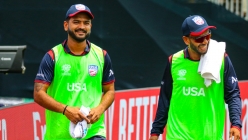Views
Four Final Questions
2019 Feb 25 by DreamCricket USA

By Tom MelvilleThe sirens that sing of the vast cricket wealth, fame, and notoriety out there for the taking in America are again calling, and this time in even higher decibels.
The sirens that sing of the vast cricket wealth, fame, and notoriety out there for the taking in America are again calling, and this time in even higher decibels.
All those who have ever heard their irresistible strains calling to these hidden treasures are, one and all, sure they're out there somewhere, like the Lost Dutchman's Gold Mine or the vanished horde of Confederate gold, even though everyone who's ever tried to find this fabled Northwest Passage of the sports world have, one and all, ended as Franklin expeditions.
But a new party has heard the call, and soon there'll be another entrant into this irrepressible quest with the recent announcement by the USACricket/ICC (and it's hard to tell, at this stage, just exactly which is calling the shots in United States cricket) of an imminent professional T20 league in this country. Coming hard on the heels of the totally misguided NIRSA initiative, which seems to have failed, after two years of trying, to get a single American to play cricket, the powers that be will now try their hand at getting Americans to watch cricket in a big way.
We say "Americans" since we have to assume these same powers that be cannot continue to operate in perpetual violation of Article 3.1 of the Constitution they themselves created, and will have to again take a crack at solving the riddle of the Great Sphinx that has immemorially baffled the cricket world; namely, how do you make a sport a broadly popular attraction in a country where 95% of the populace neither know nor care a hoot about it?
Let there be no misunderstanding. The stakes here are high, very high, and to impress upon all those involved with the enormity of the undertaking, the intense expectation that, this time around, operatives have to GET IT RIGHT, it's modestly proposed, ab amico curiae, that, as a final step in the selection process for awarding the project, after all resumes have been reviewed, all backgrounds vetted, that all applicants be required to answer the following four questions:
1) Do you, or do you not, acknowledge that there are, in this country, two separate, distinct, and polar opposite cricket markets: the mainstream American populace who have no demand for, nor interest in, this product, and the small, expat populace who are firmly pre-sold on it?
2) Do you, or do you not, acknowledge that cricket can never be commercially viable in this country on anything other than perhaps a "boutique" scale like professional lacrosse or rugby (and, yes, there is a professional rugby league in this country) unless the mainstream American market can be engaged with the game?
3) Do you, or do you not, acknowledge that if the mainstream American populace is to be successfully engaged, every facet of the game must be adapted, tailored, and modified to synchronize its appeal to what the American public fully anticipates with baseball excitement; everything from team selection, location, promotion, game tempo, even down to the conduct of the umpires? In short, that these must be cricket matches the likes of which have never before been seen on the face of the planet?
4) Do you, or do you not, acknowledge that in packaging cricket in this manner, you may alienate segments of the expat cricket community, that you are willing to run the risk of foregoing thousands of potential ticket sales or viewership? That you are willing, in short, to risk disconnecting with the 15 million in order to connect with the 300 million?
Now it shouldn't be hard to see that what's being suggested here is the application of long accepted and established business practices that every college freshman learns in their International Marketing 101 class; namely, when trying to bring a foreign product to a new market (and nothing's more foreign than a new sport) make sure you know your target market, work with locals who know the market, and modify your product to meet the demands/tastes of the local market.
A "no" answer to any of these questions is effectively a refusal to recognize these business practices and should be cause to disqualify an applicant (and, one would think, to scare away all but the most gullible investors). A "no" answer from all the applicants should be reason to pause, sit back, and seriously reconsider the advisability of sanctioning an undertaking that gives no evidence it will be anything except a sad rerun of Lauderhill, King City, or the All Stars.
However this works out, it won't be, by any means, the "last chance for American cricket" of dire prognostications (there are never "last chances" for dreamy enthusiasts). It should and must be, however, the last and final chance for the cultural outlanders and mismatched resume persons with their legacy of negligent underachievement growing the game in this country if what should be a hopeful new beginning for American cricket doesn't end up as yet another tombstone in the vast graveyard of Failed American Cricket Ventures...and the most depressingly conspicuous one.
[Views expressed in this article are the author's own and should not be interpreted as DreamCricket's views. The author is a noted cricket historian and cares passionately about cricket in the U.S.]




